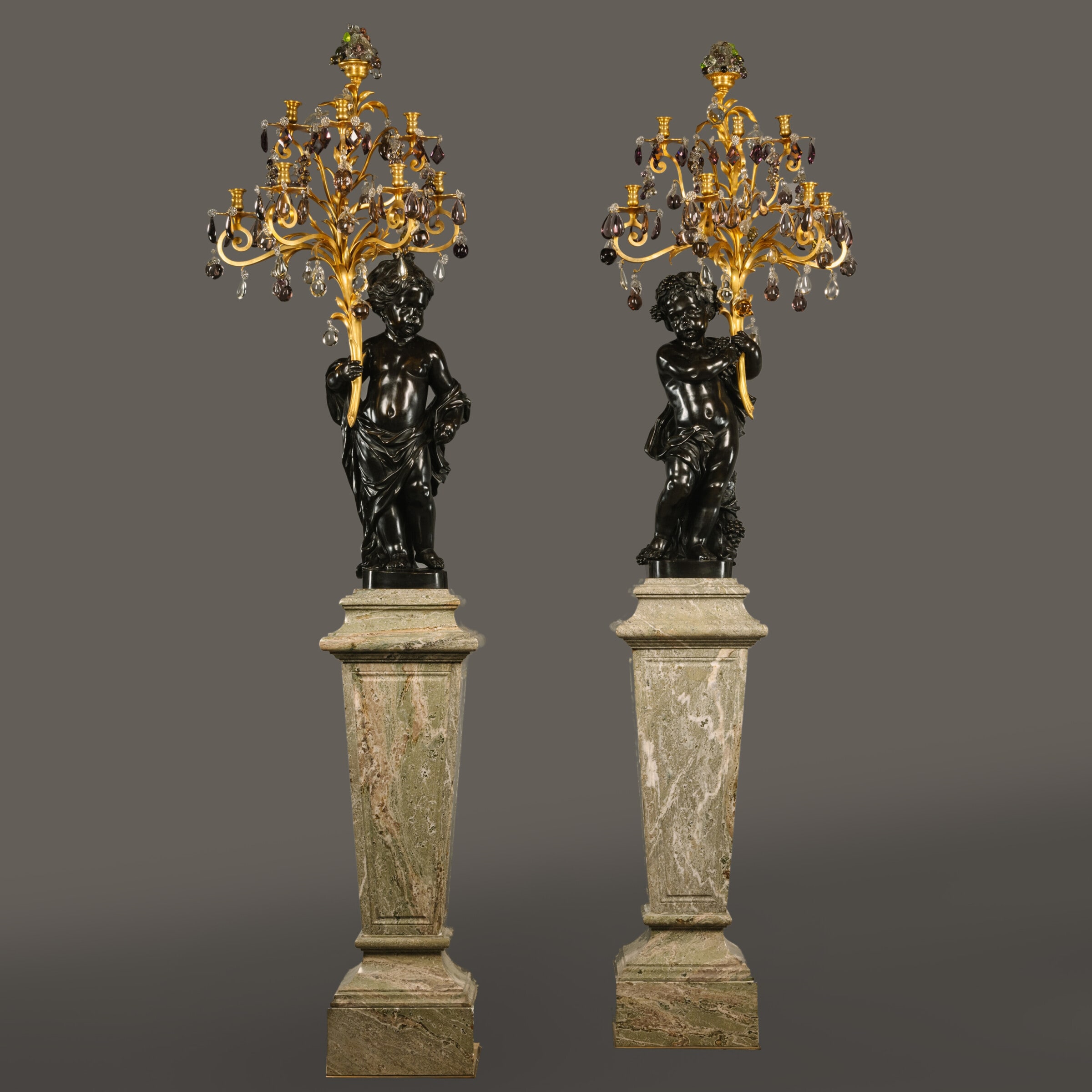润高兄弟公司
A Pair of Palatial Patinated Bronze Figural Candelabra, On Green Marble Pedestals
£160,000
A Pair of Magnificent and Palatial Patinated Bronze Figural Putto Seven-Light Gilt-Bronze, Rock-Crystal and Amethyst Glass Candelabra, On Green Marble...
尺寸
Height: 259 cm (102 in)描述
A Pair of Magnificent and Palatial Patinated Bronze Figural Putto Seven-Light Gilt-Bronze, Rock-Crystal and Amethyst Glass Candelabra, On Green Marble Pedestals.
By Raingo Frères, Paris.
Incised ‘RF’ marks for Raingo Frères.
These magnificent figural candelabra perfectly encapsulate the opulent spirit of the Belle Epoque. The dark-brown patinated bronze putto are classically robed. One putto wears a diadem headband, the other with fruiting vine. Each figure holds a candelabrum which is modelled as an acanthus leaf cornucopia issuing scrolled branches hung with amethyst, rock-crystal and glass ovate drops, facetted trapezoids, grapes and various fruits. Each candelabra stands atop a Swedish Green marble pedestals with square top above tapered panelled sides.
法国,约1900年。
Height: 259 cm (102 inches; 8 ½ feet high), overall
Height: 138 cm (54 inches), the figures
Height: 121 cm (48 inches), the marble pedestals
日期
约1900年
原产地
法国
中型
Gilt and Patinated Bronze
签名
Incised 'RF' marks for Raingo Frères
There were four Raingo brothers who began as clockmakers before expanding their business to encompass decorative bronze casting. It is not known which Raingo brother was apprenticed in Paris before moving to Belgium, circa 1800, probably for political reasons, and from the signatures on some of his clocks, it is known that he worked in Gand and Tournay. Later, in 1823, he is recorded as being clockmaker to the duc de Chartres.
The company became Raingo Frères in 1825 and thereafter clocks bear their signature with various Paris addresses. They had a workshop at 102 Rue Vielle du Temple in 1829, and from 1840 to 1850 in Rue de Saintonge. In the 1840s Raingo were accused of conterfiting Ruolz metal plating techinique which had been patented by Christofle. Specialising in the manufacture of clocks, for which they favoured sculptural ornament, and this led them to begin casting their own bronzes from the 1850s. After 1860 they moved again back to Rue Vielle du Temple where they started to sell bronzes, not from an edition but cast in a small number, generally marked with the stamp “R.F.” In 1880 the widow of Gabriel-Jules Raingo was joined her two sons, Eugène and Georges. This association was regularly extended until 1 January 1892. Eugène died in February 1895. Mme Raingo and her son Georges modified their company accordingly in July of the same year. Eugene’s rights are shared between Georges and his three sisters. The corporate name becomes “Raingo et Cie”, but the business name remains “Raingo Frères”.
The firm exhibited at many of the important exhibitions of the second half of the 19th century, including London in 1862 and Paris in 1900. Known for the fine quality of its ormolu in particular superb gilding and chasing, Raingo also cast large patinated bronze statuary for leading sculptors of the day including A. Carrier-Belleuse, Grégoire, Loison, Magnier, A. Moreau, Peyre, Pradier and Salmonson.
By the turn of the 20th century Raingo Frères are still recorded to be casting in bronze for a handful of artists, but by this time their mainstay was producing lighting along with artistic metalwork.




















 印刷品
印刷品